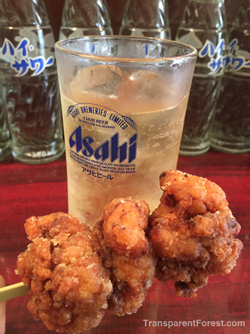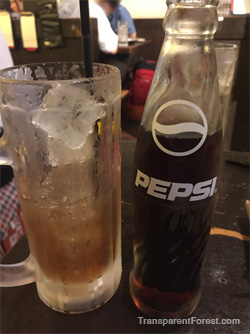TransparentForest.com
透明の森
September 26, 2015
Izakaya Drinks: Highballs and Sours

Japanese Highball and Kara-age Fried Chicken
Drinking in Japan
One of my hobbies is drinking. I like to drink for the taste, not necessarily for the buzz. Like coffee, I only drink quality items. I am picky with my beans, and I am also picky with my booze.
I typically like to drink spirits straight, or with a little bit of water, or on the rocks. I love martinis, margaritas, and whiskey.
Before moving to Japan for the third time in 2007, I mostly drank beer, wine, martinis and margaritas.
This all changed after I settled in Tokyo for the Third-time.
In the US, as well as in Japan, I mostly drink socially. When living in the US, I also occasionally drank at home mixing my own perfect martini recipe. In the US, social occasions were not as common it seems as in Japan.
In the US, you need to be careful when going out after driving to the restaurant or bar. You have to pace yourself and not get too drumk, lest you have to give the barkeep your keys and take a taxi home.
In Japan, i find myself drinking way more than in the US for two reasons.
- There are more social drinking occasions stemming from work and friends.
- In Tokyo, you can take trains and don’t have to worry about driving home drunk.
Speaking of which, I have seen many Japanese drink more than they can handle because they don’t limit themselves for the drive home. Sometimes you see professionals in nice suits and dresses parked in the corner of a train platform while trying to discreetly retch their over indulgences.
Being an American, and also being one to drink more for pleasure and not to get drunk, I find I do have the skill to not overindulge (usually).
So, how did my drinking style change after getting to Japan?
The biggest difference as I mentioned above is the frequent social drinking in Japan. They call these occasions, “nomikai”, or “drinking parties”, and they are a blast. Japanese culture is group oriented, and this is very evident during nomikais. They usually take place at “izakayas”, or Japanese style tappas bars/pubs.
Many times, the seating in izakayas are in traditional Japanese rooms with tatami floors. Othertimes, they take place around long family style tables at restaurants, or at izakayas with western style seating. This type of seating goes along with the Japanese style of group conversation, as opposed to the two or three person conversions at stand up bars in the US.
Family-style eating is the standard way to order at izakayas. Items on the menu include japanese or japanese-western style tapas or appetizers that everyone can share. All you can drink plans are common to go along with the family style eating.
These all you can drink plans usually go for about $30 US. it does seem a bit expensive, but when you remember you can drink as much as you can handle without worrying about driving home, it is a great way to unwind, have fun with friends, and get your fill of tasty drinks.
After going to several of these events, I started to realize how differently Japanese drink compared to me. Beer and wine is common enough, but the wine is served in tiny glass, and the red wine is often chilled. You have to specify room temperature for reds if you want to drink them that way.
The beer on the other hand is sold in tall glass mugs ice cold. After a hard day of work or after sports, it is very refreshing!
Besides beer and wine, I was intrigued to see how Japanese handle spirits. They almost never drink them straight (except for sake), and usually mix them with one or more non-alcoholic beverages.
Out of these, it seems to me the two most popular kinds are “Highballs” and “Sours”.
Highballs
“Highballs” are just like the western equivalent, which are defined as a spirit mixed with a larger portion of non-alcoholic beverage in a tall glass.
But this is where the similarity ends. “Highballs” usually mean only “whiskey” + “some form of carbonated beverage”. And the carbonated beverage is usually soda water.
Out of “highballs”, the most common type is “Suntory Kakubin” whiskey with soda. This is type of highball is sometimes called “Kaku-high” as well. “Kakubin” means “square bottle” and it is Suntory’s most popular brand of whiskey . The bottle is made of square glass with beveled “scales” on it, thus the naming “kakubin”. It is brilliant marketing as the bottle and naming is very distinctive.
The photo at the top of this posting shows a high-ball in a large tumbler with a very popular food paring: Japanese friend chicken or “kara-age”.
If Japanese order a different form of highball from the standard, they call it something else.
For example “Ginger High” is whiskey and ginger ale.
Besides “Highballs”, Japense also drink a category of mixed drink called a “Sour”. This is also known as “Chu-Hai”, which is short for “shochu higball”. Shochu is a form of native Japanese vodka made from potato or wheat. Sours are usually served in izakayas or restaurants, and “chu-hais” are usually sold as canned beverages, but the ingredients are the same.
Sours
Sours are similar to the western style of sour cocktail in that they are often a spirit mixed with a sour type of juice, like lemon or lime, and soda.
The similarity ends here, because Japanese sours usually do not use sweet mixers, and the base spirit is usually shochu and not gin or whiskey.
They also look different, in that they are served many times in large glass mugs or tumblers instead of half-highball glasses.
There is a large variety of mixers for Japanese sours including various sweet juices as wells as sour ones, but usually not together
The most common fruit mixers seem to be lemon juice, lime juice, grapefruit juice, or plum syrup.
Besides juices, sours also can be mixed with teas, as in green tea and ulong tea. In the case of these varieties, no soda is added.
There is also another type of sour that you mix yourself called a “Hoppy Set”.
“Hoppy is a type of non-alcoholic malt beverage. A bottle of it (you can choose light or dark) is pared with a glass of shochu on ice.
You pour in the hoppy yourself. Since the bottle of hoppy can fill more than one glass of shochu and ice, you can order more shochu called “naka” to put back into the mix after you finish the first glass of a hoppy set.
The other day, I saw a variation of a “hoppy set” sold with “cola” instead. This was called a “cola sour”. This is illustrated by the photo below.

A bottle of pepsi paired with shochu and ice.
In conclusion
Drinking in izakayas is a great way to relax. The different types of highballs or sours are nice drinks to go with lively conversation.
If you ever find yourself in Japan and you are over 21, I highly recommend trying many varieties of Highballs and Sours.
Below, I will summarize what Highballs and Sours are, as the names and types tend to blur together.
Until my next blog, have fun and drink responsibly!
Japense Mixed Drinks: Highballs and Sours Reference
Highballs
Sprits:
- Suntory Kaku-hai
- Suntory Torys
- Nikka clear
- Nikka black
Non aloholic Mix-ins
- Soda water
- Ginger ale
Garnish
- Lemons
- Limes
Sours
Spirits list
- Shochu
- Vodka
- Umeshu
Typical Mix-ins
- Grapefruit juice
- Lemon Juice
- Lime Juice
- Green tea
- shequasar (lemon from Okinawa)
- Plum syrup
- Ulong tea
The above are the common mix-ins for the highball sour type of cocktails.
Sweet Mix-ins
- Apple
- Grapes
- Pears
- Strawberry
- Pineapples
- More
Non-juice Mix-ins
- Soda
- Green tea
- Ulong tea
- Hoppy
- Cola
- Mitsuwa Cider
- Sparkling Calpico